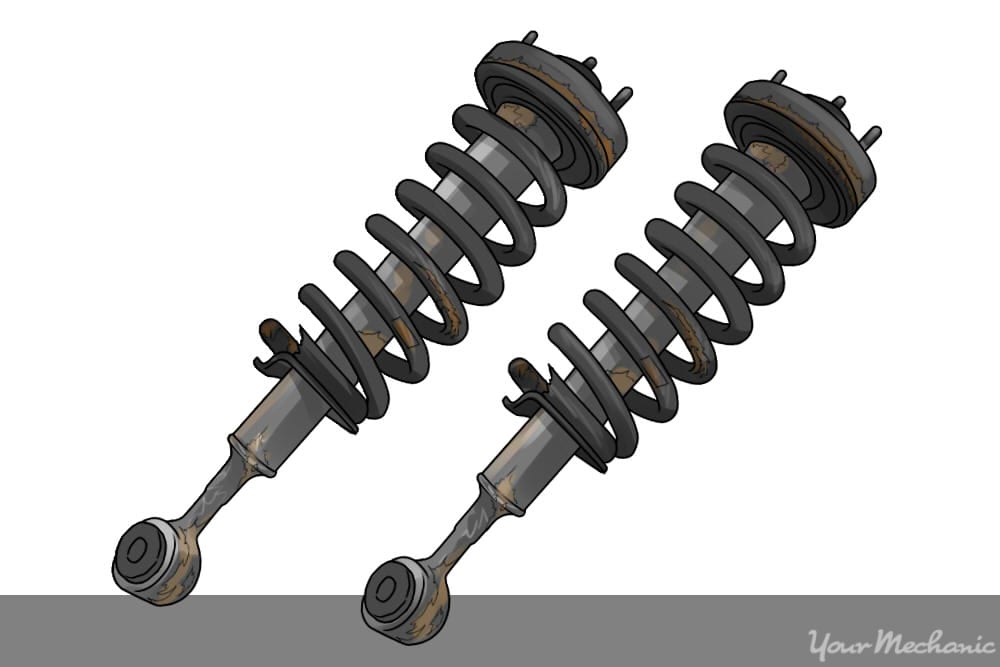

When you drive over a speed bump, pothole, or other rough roads, you’ll be thankful when the shocks and struts on your vehicle are working well. While these two vehicle components are often discussed together, they are individual parts that provide a vital service for keeping your vehicle sturdy and safe. If you’ve ever wondered about the difference between shocks and struts, this article should shed some light. Let’s take some time to break down what a shock is and a what strut is, the duties they perform, and what happens when they wear out.
Are Shocks and Struts the Same Part?
Each vehicle driving down the road today has a vehicle suspension system comprised of multiple individual parts — including shock absorbers (or struts) and springs. Springs are designed to support the vehicle and cushion the ride when the vehicle strikes objects in the road. The shock absorbers (also known as struts) limit the vertical travel or motion from the springs along with absorbing or soaking up the impact from road obstructions.
People typically use the terms shocks and struts to describe the same part since they actually serve the same function. However, there is a difference in the design of the shocks and the strut — and each has unique advantages and disadvantages:
- The primary difference between a strut and shock is in the design of the individual suspension system.
- All vehicles will use a shock or a strut on each of the four corners. Several use struts on the front with a shock absorber in the rear.
- Struts are used on vehicles without an upper control arm and connect to the knuckle while vehicles with an upper and lower control arm (independent suspension) or a solid axle (on the rear) use shock absorbers.
What is a Shock Absorber?
A shock absorber is designed to be slightly stiffer than a strut. This is mainly because they work with ancillary suspension components to absorb the shock from the road. There are 3 main types of shock absorbers:
- Mono-tube Shock Absorber: The most common type of shock absorber used is a mono-tube (or gas) shock absorber. This component is made from a steel tube with a rod and piston installed inside. As the vehicle drives over a bump, the piston pushes upward and is compressed slowly by gas for a smoother transition.
- Dual Shock:A dual or twin-tube shock features two vertical tubes that are filled with hydraulic fluid as opposed to gas. As it’s compressed, fluid is transferred to the secondary tube.
- Coil-Over Shocks: Vehicles with shock absorbers installed on the front are typically called coil over shocks — they have a shock absorber that is ‘covered’ by a coil spring.
What is a Strut?
The most common type of strut is referred to as the MacPherson strut. This is a very sturdy and durable component that combines the strut and spring into a single unit. There are some vehicles that utilize a single strut with a separate coil spring. Struts are typically mounted to a steering knuckle, with the top of the ‘spring’ installed to support the body. Struts are much smaller than shock absorbers, which is a primary reason why they are often used in vehicles with compressed suspension travel.
Should I Use a Shock or Strut in My Car?
Like any other moving part, a shock and strut are designed to wear out over time. Depending on the type of vehicle you own, they can last anywhere from 30,000 to 75,000 miles. They should be replaced as recommended by the vehicle manufacturer, and it’s always a good idea to use OEM (original equipment manufacturer) replacement parts when they require replacement. If your vehicle came from the factory with shock absorbers, you need to replace them with the same type of component. The same is to be said about struts.
Shocks and struts should always be replaced in pairs (on the same axle at the least) and the vehicle should have a professional suspension alignment completed to ensure the tires, steering, and complete suspension system is aligned straight.



